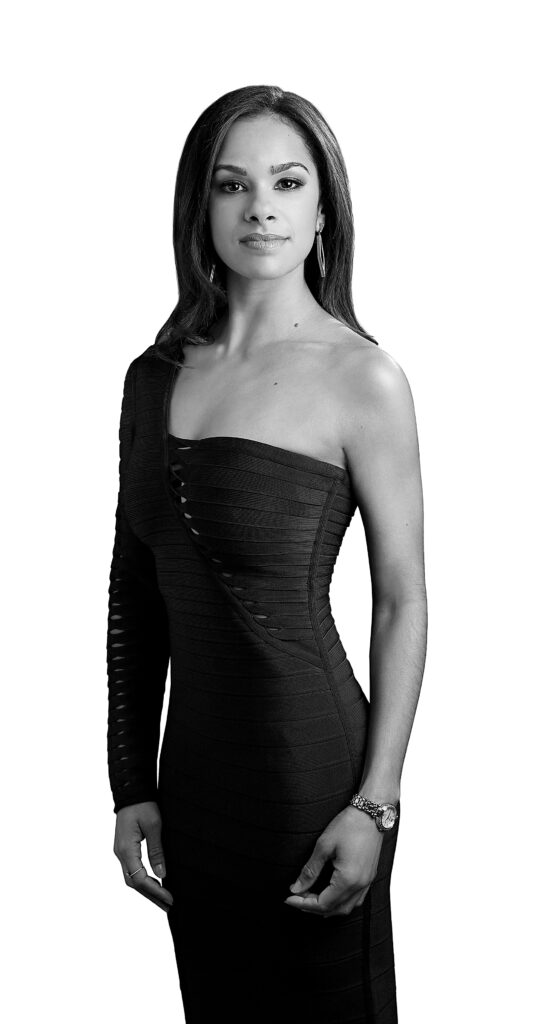Misty Copeland is principal dancer with the American Ballet Theatre, one of the leading ballet companies in the United States. Raised in San Pedro, California, she was the first Black American female dancer to be promoted to principal dancer. LMU hosted a reception for Copeland when she spoke as part of the Distinguished Speaker Series at the Redondo Beach Performing Arts Center on Oct. 20, 2022. Copeland was interviewed via email by Rosalynde LeBlanc Loo, dance professor and chair of the dance program in the LMU College of Communication and Fine Arts.

In the 2015 documentary “A Ballerina’s Tale,” you said that during your early ballet training you were judged on your aesthetic. How did you feel being measured against the traditional ballet aesthetic?
Between the ages of 13 and 17, before I became a professional, I was actually told I had the ideal body and proportions for ballet and that I was a prodigy. Once I was thrust into the professional world of dance, that’s when things got a little more complicated and not so black-and-white. I joined American Ballet Theatre and was suddenly “not right” or white enough for certain ballets. I was told I didn’t fit into the “ballet blanc” ballets where the entire group of dancers have the same skin color and wear white tutus. I was scrutinized over and over again on public forums from the elite balletomanes who felt my bust was too large and my leg muscles were too big to be in a company of the stature of ABT. All in all, when it came down to it, it was my skin color that I was being judged for while being told that it was my body that didn’t fit the ballet standard.
Do you think racism in the world of professional dance looks or operates any differently than elsewhere in U.S. society?
Absolutely! The dance community, and especially ballet, exists in a bubble that has been able to hide in plain sight when it comes to sexism and racism. Ballet tradition and history make up a big part of what it represents. Ballets created in the 1800s are still performed today and continue a narrative that is outdated and sometimes offensive. Most art forms, along with American society, have evolved to reflect the world we live in today.
When you were hired for the corps de ballet of American Ballet Theatre in 2001, you described yourself as a black ballet dancer in a white world. What is one memory that lingers the most in your mind during that time, being 19 and the “only” in predominantly white institutions?
I remember feeling a major culture shock in my first years at ABT. It was really exciting to be in New York, an incredibly diverse city. I would walk the streets and go to dinner, concerts and night clubs and see so many communities and cultures reflected. And in complete contrast, I was spending eight hours a day, five days a week in a building full of only white people. It weighed heavily on me psychologically.
In 2012, you premiered the principal role in “Firebird” but went onstage with an excruciatingly painful injury for fear, you said, of letting down the Black community if you couldn’t perform. Is there a unique pressure in being racially visible and becoming the sole symbol or spokesperson for diversity?
The issue is that Black people, whether they want to be a spokesperson for diversity, equity and inclusion or not, end up with the responsibility of having to represent their race in the classroom, boardroom, communities or on the world stage. It’s not fair, but it’s a reality. But I accept it as a beautiful responsibility filled with opportunities to build awareness and bring about change.
Can people of color see their own stories in European classical ballet? For example, having grown up as a Black girl in America, one of six siblings, with a financially insecure single mother, do you think you bring a complexity to the performances of classic ballets like “The Nutcracker” or “Swan Lake” that wouldn’t otherwise be in those stories?
Diverse representation brings complexity to ballet and challenges the stories that the classical repertoire is telling. I think that Black Americans have a place and unique voice within European culture. I have tried my best to bring my life experiences to the limited stories I have had available to me through the European repertoire, but they aren’t and never will be our stories. We are at a place now where we have the power to tell our stories and create ballets that represent us, and I think companies are more open to that now more than ever.
Ballet tends to value uniformity, conformity and heteronormative roles of men and women, especially in its embodiment of European aristocratic culture and history. Do you foresee classical ballet adapting to today’s non-binary or more fluid definitions of gender?
I absolutely do. The ballet community has grown immensely in the past three years amidst the pandemic and the rise of the Black Lives Matter movement. I look at Pacific Northwest Ballet and the way they have celebrated Ashton Edwards, who is breaking down gender barriers in ballet. I have hope that things are evolving to represent the times we live in.
A question from Gabriella Alleyne ’24, my student: “Lately, the conversation about diversity within the classical ballet space has been front and center. As a Black woman in this space, do you see significant changes being made and how do you keep encouraging these positive changes?”
I do see change happening. There are more dancers of color in ballet companies, globally as well as in roles of leadership, more than I’ve ever seen in the 20 years that I’ve been a professional. I feel it’s important for me to not only speak and encourage the dance world to continue to grow but also to uplift other Black dancers and motivate them to voice their experiences.
